 Everything was ready for StEEP. No direct competitor, developers located at the foot of the Aravis massif and, above all, a desire to finally develop a game in its own right, in order to make the studio known for something other than the multiplayer modes of Assassin's Creed. StEEP therefore presents itself as a sliding title located in a huge open-world. The latter is undoubtedly the strong point of the game since to create it, the developers simply made a best-of of the best spots in the Alps. If geographical coherence is not really on the menu, we are delighted to be able to find all the most famous areas of the Alps, broken down here into seven mountain ranges. We start with the Aravis which offer gentle slopes and coniferous forests, then we progress towards increasingly steep and inhospitable areas. We therefore find the Tyrol, the Montagnes Maudites, Switzerland, Mont-Blanc, the Aiguilles and Aosta. Each area has its own personality with a unique topography, but also fairly well-known places. You will find La Cluzaz at the foot of the Aravis, Zermatt in Switzerland at the foot of the Matterhorn, or the famous Aiguille Blanche de Peuterey next to Mont Blanc. A whimsical open-world therefore, but which condenses a lot of very real places that we take pleasure in going down. The size of the set is really mind-blowing, which guarantees a very good lifespan for the game, even if you go through it for hours and hours. Moreover, to navigate, StEEP offers a nice menu called “Mountain View” which allows us to roam freely throughout the open world in order to choose events and spawn points. Small flat all the same, since no ranking option is available, at the end of the game the whole becomes a real mess.
Everything was ready for StEEP. No direct competitor, developers located at the foot of the Aravis massif and, above all, a desire to finally develop a game in its own right, in order to make the studio known for something other than the multiplayer modes of Assassin's Creed. StEEP therefore presents itself as a sliding title located in a huge open-world. The latter is undoubtedly the strong point of the game since to create it, the developers simply made a best-of of the best spots in the Alps. If geographical coherence is not really on the menu, we are delighted to be able to find all the most famous areas of the Alps, broken down here into seven mountain ranges. We start with the Aravis which offer gentle slopes and coniferous forests, then we progress towards increasingly steep and inhospitable areas. We therefore find the Tyrol, the Montagnes Maudites, Switzerland, Mont-Blanc, the Aiguilles and Aosta. Each area has its own personality with a unique topography, but also fairly well-known places. You will find La Cluzaz at the foot of the Aravis, Zermatt in Switzerland at the foot of the Matterhorn, or the famous Aiguille Blanche de Peuterey next to Mont Blanc. A whimsical open-world therefore, but which condenses a lot of very real places that we take pleasure in going down. The size of the set is really mind-blowing, which guarantees a very good lifespan for the game, even if you go through it for hours and hours. Moreover, to navigate, StEEP offers a nice menu called “Mountain View” which allows us to roam freely throughout the open world in order to choose events and spawn points. Small flat all the same, since no ranking option is available, at the end of the game the whole becomes a real mess.
No story, no real progression, the game from Ubisoft Annecy presents itself as a big open world – of excellent quality, whether in terms of level design choices or its massive size – in which you can simply let off steam.
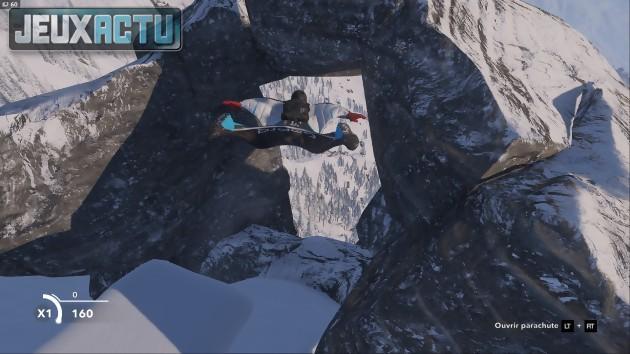 To take advantage of this huge playground, Ubisoft Annecy offers us five disciplines: skiing, snowboarding, paragliding, wingsuit, and walking. To switch from one activity to another, nothing could be simpler: just be stationary and activate a very easy-to-use selection wheel. However, being stationary means that it will be impossible to fly from your paraglider to a wingsuit in order to accelerate. Why such a choice ? For the coronation of realism. Suddenly, we wonder if we are dealing with a simulation or an arcade-oriented game. Both my friends. The game is constantly looking for itself by adding touches of realism to a rather arcade game overall. For example, if in skiing or snowboarding it is quite possible to make jumps from 60 meters high without endangering the life of your skier, a balance system has been added. Each shock is quantified in G (the measure of gravity), while your character has a gauge of 10G. Each slightly violent impact will subtract from your gauge a certain number of G, knowing that when the sum exceeds 10G, the fall is assured. In the same vein, if the impact did not put your rider on the ground, the latter will be destabilized according to the violence of the impact. At 6G, you end up with an avatar that still stands on its board, but staggers for a while until the gauge fills up again. During this time, each shock - even minimal - will be compatibilized, contributing directly to lowering the little gauge that remains. In short, avoid going crazy after a big reception, since at this point, the slightest bump in the ground can send you to the mat.
To take advantage of this huge playground, Ubisoft Annecy offers us five disciplines: skiing, snowboarding, paragliding, wingsuit, and walking. To switch from one activity to another, nothing could be simpler: just be stationary and activate a very easy-to-use selection wheel. However, being stationary means that it will be impossible to fly from your paraglider to a wingsuit in order to accelerate. Why such a choice ? For the coronation of realism. Suddenly, we wonder if we are dealing with a simulation or an arcade-oriented game. Both my friends. The game is constantly looking for itself by adding touches of realism to a rather arcade game overall. For example, if in skiing or snowboarding it is quite possible to make jumps from 60 meters high without endangering the life of your skier, a balance system has been added. Each shock is quantified in G (the measure of gravity), while your character has a gauge of 10G. Each slightly violent impact will subtract from your gauge a certain number of G, knowing that when the sum exceeds 10G, the fall is assured. In the same vein, if the impact did not put your rider on the ground, the latter will be destabilized according to the violence of the impact. At 6G, you end up with an avatar that still stands on its board, but staggers for a while until the gauge fills up again. During this time, each shock - even minimal - will be compatibilized, contributing directly to lowering the little gauge that remains. In short, avoid going crazy after a big reception, since at this point, the slightest bump in the ground can send you to the mat.
RED BULLSHIT
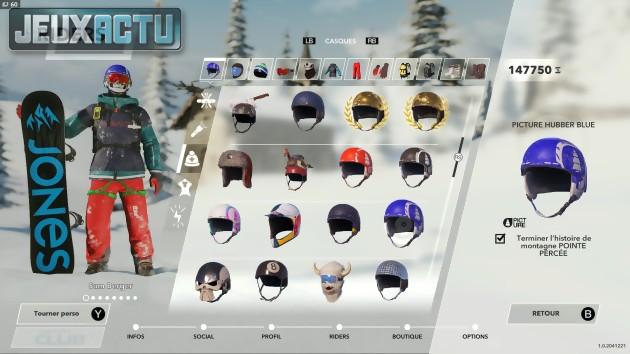 Another sign of this hesitation between simulation and arcade: the gameplay itself. Very clean, the game system is complete and rewarding, even if it requires some handling. On snow, you control the direction with the left stick, while the right stick allows you to place skids on the fly, like in real life. For figures, we jump with one of the triggers, then once out of the springboard, we send rotations with the left stick and flips with the right, while adding various grabs with the triggers (yes, the same as for the jump ). If the panel of existing figures is very real (forget the Switch Multiple Fracture 1620° SSXorcist of the series of Electronic Arts), the relaxation and the capacities of rotations of the characters are well arcades. Small black point: it will be absolutely impossible to grind. So forget rails and other funboxes in StEEP. The game also offers a system of levels and experience to progress. Between level 1 at the start of the game and level 25, you won't see a big difference, since in its realistic vein, the game offers you all the gameplay out of the box. No new figures, no improvements in game, the only interest of the levels is to unlock new, more difficult challenges in the most hostile massifs. In terms of equipment, there is a maximum of equipment to personalize your skier but, again, these are only aesthetic modifications, probably so as not to offend the brands that have provided the content of their catalog to the studio. On this point, sliding fans will be delighted since we find all the biggest brands of equipment and clothes. The skis come from the factories of Faction, Rossignol, K2, Atomic and Salomon, while the snowboards come straight from Nidecker, Jones and YES. As for the helmets, they are branded Picture, and the clothes are provided by The North Face. In short, that's good, especially since most of the equipment is available either by winning challenges or by spending the mountain of in-game cash that we accumulate very quickly and which is useless.
Another sign of this hesitation between simulation and arcade: the gameplay itself. Very clean, the game system is complete and rewarding, even if it requires some handling. On snow, you control the direction with the left stick, while the right stick allows you to place skids on the fly, like in real life. For figures, we jump with one of the triggers, then once out of the springboard, we send rotations with the left stick and flips with the right, while adding various grabs with the triggers (yes, the same as for the jump ). If the panel of existing figures is very real (forget the Switch Multiple Fracture 1620° SSXorcist of the series of Electronic Arts), the relaxation and the capacities of rotations of the characters are well arcades. Small black point: it will be absolutely impossible to grind. So forget rails and other funboxes in StEEP. The game also offers a system of levels and experience to progress. Between level 1 at the start of the game and level 25, you won't see a big difference, since in its realistic vein, the game offers you all the gameplay out of the box. No new figures, no improvements in game, the only interest of the levels is to unlock new, more difficult challenges in the most hostile massifs. In terms of equipment, there is a maximum of equipment to personalize your skier but, again, these are only aesthetic modifications, probably so as not to offend the brands that have provided the content of their catalog to the studio. On this point, sliding fans will be delighted since we find all the biggest brands of equipment and clothes. The skis come from the factories of Faction, Rossignol, K2, Atomic and Salomon, while the snowboards come straight from Nidecker, Jones and YES. As for the helmets, they are branded Picture, and the clothes are provided by The North Face. In short, that's good, especially since most of the equipment is available either by winning challenges or by spending the mountain of in-game cash that we accumulate very quickly and which is useless.
Graphically, if the title is doing well on PC, the finding is much more nuanced on consoles with a really poor rendering. Moreover, we encounter a lot of bugs, whether spawn problems or collision bugs which are quite numerous.
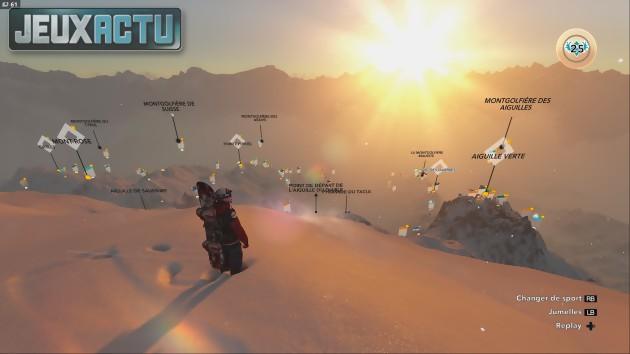 It's ultimately your schedule that StEEP is most confusing. There isn't really a clear objective or common thread to guide the player. Almost everything is available automatically, while the game rewards you for almost every action. With this in mind to appeal to all types of riders, Ubisoft Annecy has devised a system that allows you to earn points in six different branches that are supposed to correspond to your type of game. Thus, the "Freestyle" branch will fill up with each figure, the "Freeride" points will be obtained by riding ridges or rocks, and "Extreme" points by skimming obstacles or performing monstrous jumps. Moreover, each test will ask you to score according to one or the other specialty, or by combining them all. Three trees remain apart since it is "Explorer" which rewards us for each discovery, "Bone Collector" which rewards your falls, and "Pro Rider" which climbs according to the number of medals received. Even by skiing without participating in any event, you will therefore earn points if you do an action that falls into one or the other of the categories. If we stay in the nails, your schedule will be divided between challenges and "Stories of the Mountain". Challenges are simply competitions with medals at stake. Race, Freestyle, Descent of Death; in short, anything as long as you can beat a given score. These challenges represent the vast majority of the events offered by StEEP. The stories on the mountain are different and that's probably the best part of the game.
It's ultimately your schedule that StEEP is most confusing. There isn't really a clear objective or common thread to guide the player. Almost everything is available automatically, while the game rewards you for almost every action. With this in mind to appeal to all types of riders, Ubisoft Annecy has devised a system that allows you to earn points in six different branches that are supposed to correspond to your type of game. Thus, the "Freestyle" branch will fill up with each figure, the "Freeride" points will be obtained by riding ridges or rocks, and "Extreme" points by skimming obstacles or performing monstrous jumps. Moreover, each test will ask you to score according to one or the other specialty, or by combining them all. Three trees remain apart since it is "Explorer" which rewards us for each discovery, "Bone Collector" which rewards your falls, and "Pro Rider" which climbs according to the number of medals received. Even by skiing without participating in any event, you will therefore earn points if you do an action that falls into one or the other of the categories. If we stay in the nails, your schedule will be divided between challenges and "Stories of the Mountain". Challenges are simply competitions with medals at stake. Race, Freestyle, Descent of Death; in short, anything as long as you can beat a given score. These challenges represent the vast majority of the events offered by StEEP. The stories on the mountain are different and that's probably the best part of the game.
POWDER IN THE EYES
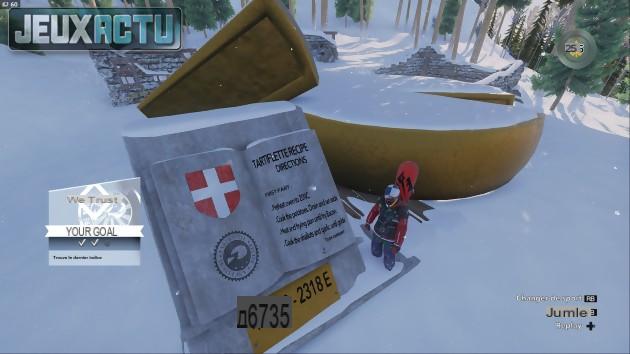 Here, no competition, the player slides for fun, with a kind of mini scenario to accompany him. The tasks are multiple and range from "follow your buddy on a night out" to challenging challenges like destroying mutant snowmen, and even a treasure hunt to find the Tartiflette recipe. It is through these missions that we get the full measure of the public StEEP is aimed at: true mountain enthusiasts who seek to deceive time when they are far from the resort and the powder-covered slopes. Moreover, the whole exploration aspect is the ultimate proof of this. Indeed, 50% of the game consists of surveying the open-world and discovering new challenges, new spawn points, but also points of interest which will then be listed in the mountain view. No interest in itself, except to have a reason to hit the slopes and have fun. An unorthodox approach but one that holds up nonetheless. Those crazy about scoring will be able to break records in the challenges, the curious will be entertained by "History of the Mountain", and snow sports enthusiasts will explore endlessly. This is also the primary use of the paraglider which will be used more to explore the massifs than to score, given the small number of events available.
Here, no competition, the player slides for fun, with a kind of mini scenario to accompany him. The tasks are multiple and range from "follow your buddy on a night out" to challenging challenges like destroying mutant snowmen, and even a treasure hunt to find the Tartiflette recipe. It is through these missions that we get the full measure of the public StEEP is aimed at: true mountain enthusiasts who seek to deceive time when they are far from the resort and the powder-covered slopes. Moreover, the whole exploration aspect is the ultimate proof of this. Indeed, 50% of the game consists of surveying the open-world and discovering new challenges, new spawn points, but also points of interest which will then be listed in the mountain view. No interest in itself, except to have a reason to hit the slopes and have fun. An unorthodox approach but one that holds up nonetheless. Those crazy about scoring will be able to break records in the challenges, the curious will be entertained by "History of the Mountain", and snow sports enthusiasts will explore endlessly. This is also the primary use of the paraglider which will be used more to explore the massifs than to score, given the small number of events available.
EXTREME-G
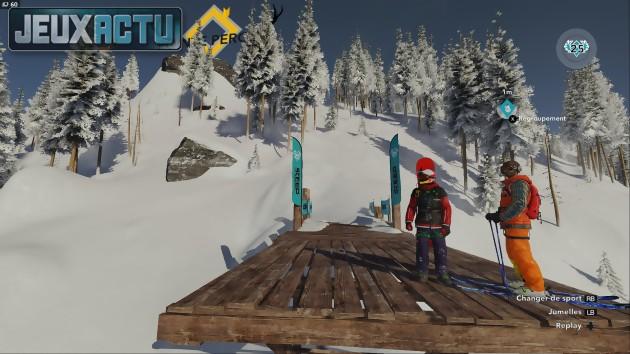 Only really incomprehensible downside: this need to play connected to a server. We already imagined a kind of MMO where interactions between players would be legion. Nay, friend. The multiplayer is so anecdotal that we still do not understand its interest. You can (sometimes) cross paths with other players, which gives the impression of a full mountain, but given the size of the universe on offer, we cannot say that the recipe works. We can also group together with other players, although we do not really understand the interest. Once together, you can always see where the other is, reach them easily via the map and enjoy a common scoreboard. Concretely, if your friend beats one of your scores, you will be invited to go get your crown and that's it. Impossible to race against each other, nor to face each other directly. Everything is done offline, asynchronously as we say. Finally, a last word to talk about the technique of the game. Graphically, if the title is doing well on PC, the finding is much more nuanced on consoles with a really poor rendering. Moreover, we encounter a lot of bugs, whether spawn problems or collision bugs which are quite numerous.
Only really incomprehensible downside: this need to play connected to a server. We already imagined a kind of MMO where interactions between players would be legion. Nay, friend. The multiplayer is so anecdotal that we still do not understand its interest. You can (sometimes) cross paths with other players, which gives the impression of a full mountain, but given the size of the universe on offer, we cannot say that the recipe works. We can also group together with other players, although we do not really understand the interest. Once together, you can always see where the other is, reach them easily via the map and enjoy a common scoreboard. Concretely, if your friend beats one of your scores, you will be invited to go get your crown and that's it. Impossible to race against each other, nor to face each other directly. Everything is done offline, asynchronously as we say. Finally, a last word to talk about the technique of the game. Graphically, if the title is doing well on PC, the finding is much more nuanced on consoles with a really poor rendering. Moreover, we encounter a lot of bugs, whether spawn problems or collision bugs which are quite numerous.

























